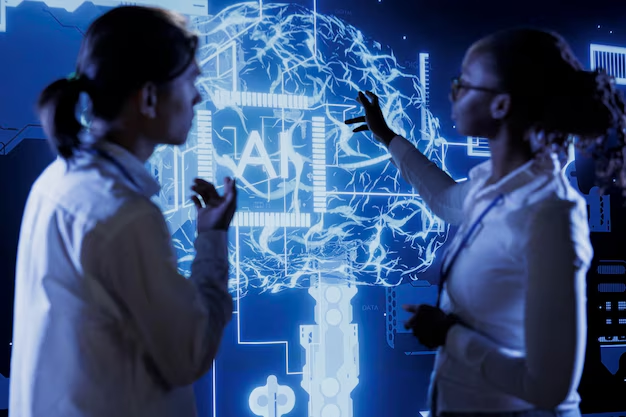In the rapidly evolving tech landscape, Artificial Intelligence (AI) and Machine Learning (ML) have emerged as groundbreaking fields with the potential to transform industries. As businesses across various sectors seek to integrate AI and ML into their operations, the need for robust development frameworks becomes crucial. Python, with its simplicity and vast ecosystem, has become the go-to programming language for AI and ML development. This article explores the role of Python in advancing AI and ML solutions, highlighting the advantages it brings to these transformative technologies.
The Role of Python in AI and Machine Learning
Python’s popularity in the AI and ML domains is no coincidence. Its versatility, combined with a rich set of libraries and frameworks, makes it the preferred choice for developers and data scientists alike. From data preprocessing to deploying complex neural networks, Python development services every stage of AI and ML development, enabling the creation of powerful models that can learn and make decisions autonomously.
Key Python Libraries for AI and ML
Python’s strength in AI and ML lies in its extensive library support, which accelerates the development process and enhances model performance. Here are some of the key libraries that make Python indispensable in AI and ML development:
- TensorFlow: Developed by Google, TensorFlow is an open-source library that allows for the creation and training of neural networks. It is widely used for both research and production-level projects.
- PyTorch: Popular among researchers, PyTorch offers dynamic computational graphs, which makes it easier to debug and experiment with models. It’s particularly favored for its flexibility and intuitive design.
- scikit-learn: This library is essential for traditional machine learning tasks such as classification, regression, and clustering. Its simplicity and efficiency make it ideal for beginners and experts alike.
- Keras: Keras is an easy-to-use, high-level neural networks API written in Python. It is capable of running on top of TensorFlow, CNTK, or Theano, making it a versatile tool for deep learning projects.
- Pandas: For data manipulation and analysis, Pandas is unmatched. It provides data structures and functions needed to manipulate structured data seamlessly.
Advantages of Using Python in AI and ML Development
Python’s dominance in AI and ML can be attributed to several key factors that make it superior to other programming languages in this domain:
- Ease of Learning and Use: Python’s simple syntax and readability make it accessible to beginners and experts alike. This ease of use allows developers to focus on solving complex AI and ML problems rather than getting bogged down by the intricacies of the language itself. This ease of use allows developers to focus on solving complex AI and ML problems rather than getting bogged down by the intricacies of the language itself. If you want to understand more about AI, you can take AI courses.
- Community Support and Resources: Python boasts a large and active community that contributes to its continuous improvement. The availability of extensive documentation, tutorials, and forums ensures that developers can find support and solutions to their problems quickly.
- Integration with Other Technologies: Python easily integrates with other languages and technologies, allowing developers to use the best tools for each task. This flexibility is particularly important in AI and ML, where different tasks may require different tools.
- Scalability and Flexibility: Python supports both object-oriented and functional programming, which allows developers to write scalable and flexible code. Whether working on a small project or deploying large-scale AI systems, Python provides the necessary tools and frameworks to achieve success.
Python in Real-World AI and ML Applications
The real-world impact of Python in AI and ML is evident across various industries. Here are some examples of how Python-powered AI and ML solutions are transforming businesses:
- Healthcare: Python is used to develop AI models that can predict diseases, analyze medical images, and even assist in drug discovery. For instance, machine learning algorithms developed in Python have been instrumental in the early detection of cancer through image analysis.
- Finance: In the financial sector, Python helps in building models that can predict market trends, detect fraudulent activities, and optimize investment portfolios. Machine learning models developed in Python have been used to analyze vast amounts of financial data to make more accurate predictions.
- Retail: Retailers use Python to create recommendation engines, optimize supply chains, and personalize customer experiences. AI models in Python analyze customer behavior to offer personalized product recommendations, thereby increasing sales and customer satisfaction.
- Manufacturing: Python is used to develop predictive maintenance models that can foresee equipment failures, thus reducing downtime and increasing operational efficiency. AI-driven quality control systems also use Python to detect defects in products during manufacturing.
The Future of AI and ML with Python
As artificial intelligence and machine learning services continue to advance, Python’s role is set to become even more significant. The continuous development of new libraries and frameworks, along with the growing adoption of Python in emerging technologies such as quantum computing and natural language processing, ensures that Python will remain at the forefront of AI and ML innovation.
Moreover, with the increasing demand for AI-driven solutions, Python’s adaptability and scalability will be crucial in developing models that can handle the complexity and volume of future AI applications. Whether it’s enhancing existing models or pioneering new AI breakthroughs, Python will be the backbone that supports these innovations.
Conclusion
Python has established itself as the cornerstone of AI and ML development, providing developers with the tools and resources needed to create powerful, scalable, and efficient solutions. Its simplicity, flexibility, and robust community support make it the ideal choice for developing AI and ML applications that can drive innovation across industries. As the AI and ML fields continue to evolve, Python will undoubtedly play a crucial role in shaping the future of these technologies.





